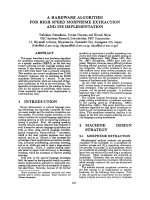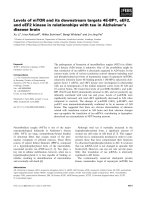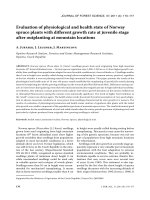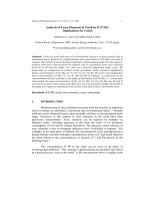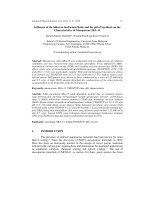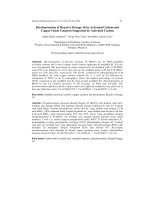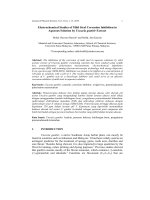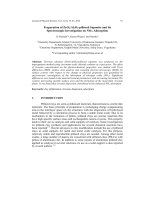Báo cáo vật lý: "Evaluation of In Vitro Antioxidant Activity of 5H-dibenz[b,f]azepine and Its Analogues" ppt
Bạn đang xem bản rút gọn của tài liệu. Xem và tải ngay bản đầy đủ của tài liệu tại đây (639.42 KB, 14 trang )
Journal of Physical Science, Vol. 21(1), 79–92, 2010 79
Evaluation of In Vitro Antioxidant Activity of
V d Nagaraja Naik
1
*
1
D re, Manasagangotri
. College,
Acha
rya 57, Andhra Pradesh, India
ara University,
dia
ing different
valuated for
ry activity on
ty in an egg
ong the compounds, (a) and (d) significantly inhibited human
(e) and (f)
were used
reference antioxidant compounds. Comparative studies with the synthesised
compounds were also performed.
LDL oxidation, lipid peroxidation, antioxidant
elated with
cancer and
are gaining
f preventive
lly useful
e generated
in various
components of the body (e.g., lipids, proteins and nucleic acids) and may also be
involved in processes leading to the formation of mutations. Furthermore, radical
reactions play a significant role in the development of life-limiting chronic
diseases such as cancer, diabetes, arteriosclerosis and others.
6
It has been
suggested that oxidative modification of low-density lipoproteins (LDLs) may
play a role in the development of atherosclerosis.
7
The oxidative modification
5H-dibenz[b,f]azepine and Its Analogues
ijay Kumar Honnaiah
1
, Ranga Rao Ambati
2
, Varakumar Sadineni
3
an
epartment of Studies in Chemistry, University of Myso
M
ysore – 570 006, Karnataka, India
2
D Y. R. Nepartment of Oils and Fats, V. R. S. &
Nagarjuna University, Chirala – 523 1
3
Department of Biochemistry, Sri Venkatesw
Tirupati – 5 7 502, Andhra Pradesh, In1
*Corresponding author:
Abstract: Synthesis of 5H-dibenz[b,f]azepine and its derivatives bear
functional groups was performed. The compounds thus synthesised were e
their antioxidant activities by following two well established assays: inhibito
human low density lipoprotein (LDL) oxidation and lipid peroxidation activi
liposome model system. Am
LDL oxidation and liposome peroxidation, whereas compounds (b), (c),
showed less activity. Butylated hydroxy anisole (BHA) and ascorbic acid (AA)
as
Key
acti
words: 5H-dibenz[b,f]azepine,
vity
1. INTRODUCTION
Free radicals and active oxygen species have been corr
cardiovascular and inflammatory diseases and even with a role in
ageing.
1,2
Efforts to counteract the damage caused by these species
acceptance as a basis for novel therapeutic approaches, and the field o
medicine is experiencing an upsurge of interest in medica
antioxidants.
3,4
Recent evidence
5
suggests that free radicals, which ar
in many bioorganic redox processes, may induce oxidative damage
Evaluation of In Vitro Antioxidant Activity 80
depends on a common initiating step, the peroxidation of polyunsat
acid com
urated fatty
ponents of LDLs.
8
Such modification of LDLs can be inhibited by
t
tures sho
w
antioxidant
the view of
g. 1) is a
ate for the
structure of
atives have
ergic activity, specifically antihistaminic,
spasmolytic, serotonin antagonistic, anticonvulsive, antiemetic, antiepileptic,
anti-inflammatory, sedative and fungicidal action.
15
an ioxidants.
9,10
In the literature some tricyclic amines and their chemical struc
antioxidant neuriprotective activity in vitro.
11
Nowadays, the
mechanism of aromatic amines (Ar
2
NHs) has been discussed from
chemical kinetics.
12
5H-dibenz[b,f]azepine i.e., iminostilbene (Fi
common basic fused tricyclic amine. It is used as an intermedi
synthesis of the registered anticonvulsant drug oxcarbazepine,
13
the
which has recently been reported.
14
Dibenz[b,f]azepine and its deriv
been variously reported as having antiall
Figure 1: Structure of 5H-dibenz[b,f]azepine.
The research on free radicals provides theoretical informati
medicinal development and supplies some in vitro methods f
optimising drugs; it is attracting increased scientific attention from
and medicinal chemists. Generally, phenolic compounds are fou
antioxidant and radical scavenging activity, and they also in
oxidation.
16,17
In addition to the traditional O–H bond type antioxidan
amines,
on for the
or quickly
bioorganic
nd to have
hibit LDL
ts, tricyclic
having N–H bond functions as the antioxidant, have attracted much
se y currently
-
to establish
tes and the
As their structures may justify a possible intervention in the free radical
process, therefore this study has been taken to explore better the chemistry and
antioxidant properties of 5H-dibenz[b,f]azepine and its derivatives. Six molecules
(a–f) were synthesised, and their structures were established by chemical and
spectral analysis. The synthesised compounds were investigated for in vitro
antioxidant potential, and a comparative study was done on commercially
re a
rch attention because Ar
2
NHs are the central structure in man
used drugs.
18
Recently, we have reported the antioxidant properties of 5H
dibenz[b,f]azepine and some of its analogues, and it was possible
some structure-activity relationships based on the different substitu
positions.
19
Journal of Physical Science, Vol. 21(1), 79–92, 2010 81
available synthetic antioxidants, namely butylated hydroxy anisole (BHA) and
ascorbic acid (AA).
RIMENTAL
2.1
micals Co.
naldehyde.
phosphate,
H were of
oints of the
ncorrected.
kin Elmer,
pectra were
eter (Joel
TMS) as an
s. The
mass
er (Hitachi
en with the
in brackets. The purity of the compounds was checked
thin la
fied by column
hr n a silica gel (60–120 mesh) bed as adsorbent and hexane and
th
of o-nitro
nol in the presence of the catalyst ethyl formate and
KO yl (o,o'-
f]azepine
r 3 hr and
g for 2 hr to
e.
Orange yellow solid, yield 82%, m.p. 197
o
C–201
o
C. IR (KBr)ν
max
(cm
–1
): 3360.0 (N–H), 3046.3 (Ar–H).
1
H NMR (δ, CDCl
3
): 3.3 (s, 1H, N–H),
6.7–8.1 (m, 8H, Ar–H), 7.0 (m, 2H, 7 membered Ar–H). Mass (%): M
+
193.16
(90), 195 (5), 196 (11). Anal. Calc. for C
14
H
11
N: C, 87.01; H, 5.74; N, 7.25.
Found: C, 87.00; H, 5.77; N, 7.26.
2.
EXPE
Protocols
The following reagents were obtained from Sigma Che
(St. Louis, MO, USA): 1,1,3,3 tetra methoxy propane and mala
Copper sulphate, sodium dihydrogen ortho phosphate disodium ortho
TBA, TCA, NaCl, ferric chloride, L-ascorbic acid, HCl and NaO
analytical grade and obtained from Merck, Mumbai, India. Melting p
compounds were determined by the open capillary method and are u
The IR spectra were recorded on a FT-IR 021 model (Per
Massachusetts, USA) in a KBr disc and in nujol mull. The
1
H NMR s
recorded on a Jeol-60 MHz and Jeol GSX 400 MHz spectrophotom
Ltd., Tokyo, Japan) using CDCl
3
as a solvent and tetramethylsilane (
internal reference. The chemical shifts are expressed in δ (ppm) value
spectra were recorded on a Hitachi RMU-61 spectrophotomet
Seisakusho Co. Ltd., Tokyo, Japan), and important fragments are giv
percentage of abundance
by yer chromatography on silica gel glass plates in a hexane and ethyl
acetate solvent mixture (9:1 v/v). The compounds were puri
omatography oc
e yl acetate as eluent (9:2 v/v).
2.1.1 Procedure for the preparation of 5H-dibenz[b,f]azepine
(Compound a)
5H-dibenz[b,f]azepine (a) was prepared by the coupling
toluene (2 mM) in metha
H (1 mM) in methanol by refluxing for 4 hr to form bibenz
dinitroazepine). This was reduced to give 10,11-dihydro-5H-dibenz[b,
(1) upon refluxing with phosphoric acid, a cyclisation agent, fo
dehydrogenation with CaO in dimethyl aniline solution upon refluxin
obtain 5H-dibenz[b,f]azepin
Evaluation of In Vitro Antioxidant Activity 82
2.1 paration of 5H-dibenz[b,f]azepine-5-
resence of
yl
dibenz[
b,f]azepine (0.253 g, 10 mM), which upon further reflux with
con oxamide.
–1
): 3421.0–
3
6.9 (s, 2H,
2
Ar–H). Mass (%): M
+
H
12
N
2
O: C, 76.25; H,
5.1 C, 76.26; H, 5.13; N, 11.88; O, 6.74.
luxing 5H-
r.
85%, m.p. 159 C–162 C. IR (KBr)ν
max
(cm
–1
): 3069.0
(Ar–H), 1668.9 (C=O).
1
H NMR (δ, CDCl ): 7.2–7.5 (m, 8H, Ar–H), 7.0 (d, 2H,
38 (10), 239
1 or C
16
H
13
NO: C, 81.68; H, 5.57; N, 5.95; O, 6.80. Found: C,
.
,f]azepine
brominating
, to the
nd refluxed
Yellow solid, yield 87%, m.p. 181
o
C–183
o
C. IR (KBr)ν
max
(cm
–1
):
3416.0–3469.1 (NH
2
), 3163.4 (Ar–H), 1690 (C=O).
1
H NMR (δ, CDCl
3
): 3.3
(s, 1H, N–H), 6.8–7.9 (m, 8H, Ar–H), 6.9 (m, H, 7 membered Ar–H), 3.8 (s, 3H,
OCH
3
). Mass (%): M
+
223.15 (88), 225 (7), 227 (11). 229 (1). Anal. Calc. for
C
15
H
13
NO: C, 80.69; H, 5.87; N, 6.27; O, 7.17. Found: C, 80.68; H, 5.88; N,
6.25; O, 7.18.
.2 Procedure for the pre
carboxamide (Compound b)
5H-dibenz[b,f]azepine (1.93 g, 10 mM) was refluxed in the p
COCl
2
with a strong base (NaNH
2
) for 4 hr to obtain chloro carbon
centrated ammonia (25 ml) yielded 5H-dibenz[b,f]azepine-5-carb
White solid, yield 81%, m.p. 190
o
C–193
o
C. IR (KBr)ν
max
(cm
3465.4 (NH
2
), 3163.4 (Ar–H), 1671 (C=O).
1
H NMR (δ, CDCl ):
NH ), 7.3–7.5 (m, 8H, Ar–H), 7.0 (m, 2H, 7 membered
236.
15 (88), 238 (7), 269 (11), 239 (1). Anal. Calc. for C
15
2; N,
11.86; O, 6.77. Found:
2.1.3 Procedure for the preparation of 1-5H-dibenz[b,f]azepine-
5yl)ethanone (Compound c)
1-5H-dibenz[b,f]azepine-5yl)ethanone was prepared by ref
dibenz[b,f]azepine (1.93 g, 10 mM) in acetic anhydride (25 ml) for 6 h
Brown solid, yield
o o
3
7 mem
bered Ar–H), 2.0 (s, 3H, CH
3
). Mass (%): M
+
235.18 (91), 2
). Anal. Calc. f(1
81 6
9; H, 5.55; N, 5.98; O, 6.81.
2.1.4 Procedure for the preparation of 10-methoxy-5H-dibenz[b
(Compound d)
10-methoxy-5H-dibenz[b,f]azepine was prepared by
N-acetyl-5H-dibenz[b,f]azepine (2.35 g, 10 mM) using bromine (3.2 g, 20 mM)
in dichloromethane (25 ml) to obtain dibromo derivative. Furthermore
above solution, KOH (1.12 g, 20 mM) in CH
3
OH (25 ml) was added a
for 4 hr to obtain the product.
Journal of Physical Science, Vol. 21(1), 79–92, 2010 83
2.1 sis of 5-chlorocarbonyl-10-11-dihydro-5H-
y
g, 10 mM) with COCl
2
–1
): 3163.4
, 4H,
ass (%): M
+
257.47 (82), 259 (10), 260 (1), 261 (1). Anal.
Cl, 13.76. Found: C, 69.90;
repared by
loride
C. IR (KBr)ν
max
(cm
–1
): 3163.4
(Ar–H), 1690 (C=O).
1
H NMR (δ, CDCl
3
): 7.3–7.6 (m, 8H, Ar–H), 3.0 (s, 4H,
) 3163.4 (Ar–H), 1.9 (s, 3H, CH3). Mass (%): M
+
237.17 (79),
9 37; N, 5.90;
derivatives
anges in the
outlined in
to obtain compound (e), the reaction was carried out
y using a weak base (triethyl amine) with COCl
2
at room temperature (RT)
ead of triphosgene in the presence of NaNH
2
as a strong base in the reflux
con i.e., acetyl
f NaNH
2
, a
2.3 Pharmacology
In the present study, the synthesised compounds (a–f) were evaluated for
their inhibitory activity on human LDL oxidation and antilipid peroxidation
activity in a liposome model system. The compounds were dissolved in distilled
.5 Procedure for the synthe
diben
z[b,f]azepine (Compound e)
5-chlorocarbonyl-10-11-dihydro-5H-dibenz[b,f]azepine was obtained b
reacting 10,11-dihydro-5H-dibenz[b,f]azepine (1.95
(25 m
l) in the presence of triethyl amine as base at RT for 8 hr.
White solid, yield 91%, m.p. 149
o
C–151
o
C. IR (KBr)ν
max
(cm
(Ar–H), 1683 (C=O).
1
H NMR (δ, CDCl
3
): 7.2–7.6 (m, 8H, Ar–H), 3.1 (s
7 membered ring). M
Calc. for C
15
H
12
NOCl: C, 69.91; H, 4.69; N, 5.43;
H, 4.67; N, 5.44; Cl, 13.77.
2.1.6 Procedure for the synthesis of 1-(10,11-dihydro-5H-
dibenz[b,f]azepin-5-yl)ethanone (Compound f)
1-(10,11-dihydro-5H-dibenz[b,f]azepin-5-yl)ethanone was p
reacting 10,11-dihydro-5H-dibenz[b,f]azepine (1.95 g, 10 mM) in acetylch
(25 ml) for 6 hr at RT.
White solid, yield 88%, m.p. 153
o
C–156
o
7 mem
bered Ar–H
23 (7), 2
40 (11), 242 (1). Anal. Calc. for C
16
H
15
NO: C, 80.98; H, 6.
O, 6.74. Found: C, 80.96; H, 6.37; N, 5.92; O, 6.73.
2.2 Chemistry
In the present work, 5H-dibenz[b,f]azepine and some of its
were synthesised according to the published literature
13
with slight ch
chemical reagents and conditions. The reaction sequences are
schemes 1–3. In scheme 3,
b
inst
dition, and co
mpound (f) was obtained by using acid chloride,
chloride, at RT instead of using acetic anhydride in the presence o
strong base in the reflux condition.
Evaluation of In Vitro Antioxidant Activity 84
ethanol (50 ml) to prepare 1000 µM solutions. Solutions of different
3 odel
peroxidation-inhibitory activity of the 5H-dibenz[b,f]azepine
d its analogues in a liposome model system was determined according to the
pub
cated in an
, Berlin,
/ml) were
st samples).
and 10 µl of
eaction was
chloroacetic
ion mixture
t 1500 rpm
nt was read
a spectrophotometer. An identical experiment was performed in
the absence of the compound to determine the amount of lipid peroxidation
obtained in control experiment. The
ity (% ALP) was calculated using the
nteers, and
r 10 min at
ated plasma
centrifuge
as prepared
as estimated
d LDL was
.4 sterilised
by filtration (0.2-µm Millipore membrane system, USA) and stored at 4
o
C under
nitrogen. Plasma was separated from blood drawn from human volunteers and
stored at 4
o
C until used. Compounds with various concentrations (5, 10 and 15
µM) were taken in test tubes, and 40 µl of copper sulphate (2 mM) was added;
the volume was increased to 1.5 ml with phosphate buffer (50 mM, pH 7.4). The
test tube without compound and with copper sulphate served as a negative
concentrations (5, 10,
15, 25, 50 and 100 µM) were prepared by serial dilution.
2. .1 Inhibitory activity of lipid peroxidation in egg liposome m
The lipid
an
lished method.
20
Egg lecithin (3 mg/ml phosphate buffer, pH 7.4) was soni
ultrasonic homogeniser (Son plus HD 2200, Bandelin Company
Germany). Compounds of different concentrations (5, 10 and 15 µM
added to 1 ml of the liposome mixture and to the control (without te
Lipid peroxidation was induced by adding 10 µl of FeCl
3
(400 mM)
L-ascorbic acid (200 mM). After incubation at 37
o
C for 1 hr, the r
terminated by adding 2 ml of 0.25 N HCl containing 150 mg/ml tri
acid (TCA) and 3.75 mg/ml of thiobarbutaric acid (TBA). The react
was subsequently boiled for 15 min, cooled to RT and centrifuged a
for 15 min, and the absorbance (optical density, OD) of the supernata
at 532 nm with
the presence of inducing agents as a
percentage of antilipid peroxidative activ
uation: following eq
ALP (%) = [1 – (sample OD/blank OD)] 100
2.3.2 Inhibition of human LDL oxidation
Fresh blood was obtained from fasting adult human volu
plasma was immediately separated by centrifugation at 1500 rpm fo
4
o
C. LDL [0.1 mg LDL protein/ml] was isolated from freshly separ
by preparative ultra centrifugation using a Beckman L8–55 ultra
(United Biomedical Sales & Service Corp., New York). The LDL w
from the plasma
21
using a differential ultra centrifugation. Protein w
in compounds by using the method as in Lowry et al.
22
The isolate
extensively dialysed against phosphate buffered saline (PBS) at pH 7
Journal of Physical Science, Vol. 21(1), 79–92, 2010 85
control, and another test tube with compound and without copper sulp
as a positive control. All the tubes were incubated at 37
o
C for 45 m
aliquot was drawn at 2, 4 and 6 hr intervals from each test tube, and 0.25
TBA (1% in 50 mM NaOH) and 0.25 ml of TCA (2.8%) were added. Th
were again incubated at 95
o
C for 45 min. Furthermore, the tubes wer
to RT and centrifuged at 2500 rpm for 15 min. A pink
(malondialdehyde, MDA) was extracted by centrifugation at 200 rpm
and the absorbance was recorded at 532 nm using a spectrophotomete
appropriate blank. Data were expressed in terms of MDA equivalen
by comparison with standard graph drawn for 1,1,3,3-tetrametho
(which was used as a standard), which gave the amount of oxidation.
were expressed as protection per u
hate served
in. A 1 ml
ml of
e tubes
e cooled
chromogen
for 10 min,
r against an
t, estimated
xy-propane
The results
nit of protein concentration [0.1 mg LDL
as calculated
using the formula:
( in experimental/oxidation in control) 100.
gues were
ihydro-5H-
urthermore,
tives (b–f)
d by IR,
1
H
compounds
m
–1
and the
unds (a) and
d the absence of C=O stretching were
he
1
H NMR spectra, compounds (a) and (d) showed the N–H proton
as a singlet at about 3.3 ppm, but it was not observed in compounds (b), (c), (e)
and (f). All the other aromatic protons were observed at the expected regions in
all the synthesised compounds. The mass spectra of compounds showed the M
+
peak, in agreement with their molecular formula.
protein/m
l]. Using the amount of MDA, the percentage protection w
oxidation in control – oxidation
3. RESULTS AND DISCUSSION
In the present work, 5H-dibenz[b,f]azepine and its analo
synthesised. Schemes 1–3 illustrate the preparation of the target molecules. As a
starting material nitro toluene was used to produce 10,11-d
dibenz[b,f]azepine (1) and 5H-dibenz[b,f]azepine (a) (Scheme 1). F
these two molecules were used for the preparation of the deriva
(Schemes 2 and 3). The structures of the compounds were elucidate
NMR,
mass spectroscopy and elemental analysis. The IR spectra of
(e) and (f) showed the absent of the N–H absorption band at 3400 c
presence of t
he C=O stretching band at 1600 cm
–1
, whereas in compo
(d), the presence of N–H stretching an
observed. In t
NO
2
NO
2
NO
2
C
2
H
5
ONa, KOH
eth l formate,
reflux 4hr
ethylene diamine
reflux 3 hr
y
NH
2
ethyl formate,
reflux 4 hr
NH
2
p
h
o
s
p
h
o
r
i
c
a
ci
d
reflux 4 hr
N
reflux 4 hr phosphoric acid
H
N
dimethyl aniline
CaO, reflux 2 hr
H
(1)
Scheme1: Protocol for the synthesis of compound (a).
Note: (1) represents 10,11-dihydro-5H-dibenz[b,f]azepine
(a)
(l)
(a)
N
H
2
N
O
N
H
COCl
2
,NaNH
2
Ammonia
reflux 4hr
acetylchloride
N
acet
y
chloride
re
flux, 6hr
O
N
H
H
3
CO
Bromine
KOH, reflex 4 hr
(b)
(c)
(d)
Scheme 2: Protocol for the synthesis of compounds (b), (c) and (d).
(b)
(c)
(d)
ammonia
reflux 4 hr
reflux 6 h
r
(a)
bromine
Journal of Physical Science, Vol. 21(1), 79–92, 2010 87
N
Cl
O
N
H
COCl
2
,
acetyl chloride
N
RT, 6hr
O
(e) (f )
Triethyl amine
RT, 8hr
Scheme 3: Protocol for the synthesis of compounds (e) and (f).
akes part in
ells.
23
Lipid
rioration of
membrane
the double
a molecular
cts with an
n extract a
gen atom to
OH. A probable alternative fate of the peroxy
to form a cyclic peroxide; these cyclic peroxidase, lipid peroxides and
cyc ymerisation
y the
of oxidative
ee radicals,
scavenging
chromogen,
eroxidation
me system,
(a) and (d)
ent manner.
ibit 86.20%
, (e) and (f)
N–H group,
which can donate hydrogen atoms, in compounds (a) and (d) may contribute to
the lipid peroxidation activity. The presence of the methoxy group at the 10
th
position of the 7 member ring addition to the free N–H group in compound (d)
may be responsible for better activity than compound (a). The presence of the
methoxy group in the seven member ring may enhance the stability of the
nitrogen centred radical due to the electron conjugation effect. The absence of N–
RT, 6 hr
COCl
2
triethy amine
RT, 8 hr
(e) (1)
(f)
Note: (1) represents 10,11-dihydro-5H-dibenz[b,f]azepine
In biological systems, MDA is a highly reactive species and t
the cross-linking of DNA with proteins and also damages liver c
peroxidation
has been broadly defined as the antioxidative dete
polyunsaturated lipids. The initiation of a peroxidation sequence in a
or unsaturated fatty acid is due to extraction of a hydrogen atom from
bond in the fatty acid. The free radical tends to be stabilised by
rearrangement to produce a conjugate diene, which then easily rea
oxygen molecule to give a peroxy radical.
24
Peroxy radicals ca
hydrogen atom from another molecule, or they can extract a hydro
give a lipid hydroperoxide, R–O
radical is
lic endoperoxides fragment to aldehydes including MDA and pol
products. MDA is the major product of lipid peroxidation and is used to stud
lipid peroxidation process in egg lecithin.
Lipid peroxidation is a free radical meditated propagation
damage to polyunsaturated fatty acids involving several types of fr
and termination occurs through enzymatic means or by free radical
by antioxidants. TBA reacts with MDA to form a diadduct, a pink
which can be detected spectrophotometrically at 532 nm. The lipid p
activity of the 5H-dibenz[b,f]azepine and its derivatives in the liposo
induced by FeCl
3
plus AA, is represented in Figure 2. Compound
showed promising ALP activity like AA and BHA in a dose depend
From the graph, at a 5 µM concentration, compounds (a) and (d) inh
and 93.12% of the activity, respectively, whereas compounds (b), (c)
showed no significant effect on ALP activity. The presence of the
Evaluation of In Vitro Antioxidant Activity 88
hinder their lipid
peroxidation ability and shows negligible activity in the liposome model.
H group in the other compounds (b), (c), (e) and (f) may
Figure 2: Inhibition of lipid peroxidation (%) in the liposome mode
5H-dibenz[b,f]azepine and its five analogues at different concent
and 15 M/ml). Values represent means ± SD (n = 3).
The polyunsaturated fatty acids (PUFA) of human LDL we
and the MDA formed was estimated using the TBA method. The
activity of compounds against human LDL oxidation at different co
is shown in the Figure 3. Compounds (a) and (d) showed 85.44% a
protection at 5 µM level, 92.94% and 94.76% protection at 10 µM
94.69% and 96.39% protection at 15 µM respectively, 6 hr after the i
oxidation. The results indicate a dose dependent effect of the compo
LDL oxidation. Compounds (b), (c), (e) and (f) showed less activit
LDL oxidation, whereas compounds (a) and (d) contain free amino g
bond) that can quench the radical and may inhibit the LDL o
Introducin
g the electron donating group OCH
3
on the seven mem
compound (a) leads to a considerable increase in the antioxidant
compound (d). In the case of compounds (b), (c), (e) and (f), the abs
N–H and –OCH
3
groups may be responsible for the lower antioxidant
human LDL oxidation. Hence, in this assay, compounds (a) and (d) i
stabilise the antioxidant activity compared to the other compounds
l system by
rations (5, 10
re oxidised,
antioxidant
ncentrations
nd 92.13%
level, and
nduction of
und against
y on human
roups (N–H
xidation.
11,25
ber ring of
activity of
ence of free
capacity on
ncrease and
at different
time intervals. The percentage inhibition of LDL oxidation for the standards like
BHA and AA was also determined and compared with those of the synthesised
compounds (Fig. 3). The antioxidant activity of BHA and AA was still lower
than that of the compounds (a) and (d). In general, the antioxidant activity on
human LDL oxidation observed in the present study was in the following order:
(d) > (a) > AA > BHA > (b) > (c) > (f) > (e). These results predict that the
5 10 15
a b c d e
f
AA
BHA
Concentration (
M//ml)
ALP (%)
100
80
60
40
20
0
0
20
40
60
80
100
246
Time (h)
Antioxidant activity (%)
a b c d e f AA BHA
5 µ M
a
b
c
d
e
f
AA
BHA
5 M
100
80
60
40
20
0
(%) Antioxidant activity
2
4
6
Time (h)
0
20
40
60
80
100
246
Time (h)
Antioxidant activity (%)
a b c d e f AA BHA
10 µ M
a
b
c
d
e
f
AA
Antioxidant activity
10
M
100
80
60
40
20
0
(%)
2
4
6
Time (h)
BHA
0
246
Anti
20
40
60
80
100
Ti
me (h)
oxidant activity (%)
a b c d e f AA BHA
15 µ M
15
M
Antioxidant activity
100
80
60
40
20
(%)
0
2
4
6
Time (h)
a
b
c
d
e
f
BHA
AA
Figure 3: Antioxidant activity (%) of 5H-dibenz[b,f]azepine and its five analogues on
human LDL oxidation at different concentrations (5, 10 and 15 M/ml of
LDL). Values represent means ± SD (n = 3).
Evaluation of In Vitro Antioxidant Activity 90
antioxidant activity of 5H-dibenz[b,f]azepine and its derivatives on h
oxidation and lipid peroxidation acti
uman LDL
vity in the liposome system could be related
to their direct radical scavenging properties.
4.
sised 5H-
agents and
activity for
ts, we can
ine (a), and
antioxidant
both in the
ctivity was
ivable from
some of its
This study
d supplies
quickly optimising drugs; our study indicates that 5H-
dibenz[b,f]azepine and some of its derivatives can be used as a source of
synthetic antioxidants, which could contribute to health benefits. Studies on the
ant ies of newly synthesised compounds bearing different
ing matures.
B. & Gutteridge, J. M. C. (1989). Free radical in biology and
cer risk. Nut. Rev., 50,
e-antioxidant
al Biol. Med.,
5. Yen, G. C. & Chen, H. Y. (1995). Antioxidant activity of various tea extracts in
relatio
n to their antimutagenicity. J. Agric
. Food Chem., 43(1), 27–32.
6. Moskovitz, J., Yim, M. B. & Chock, P. B. (2000). Free radicals and disease.
Arch. Biochem. Biophys., 397(2), 354–359.
7. Jialal, I. & Devaraj, S. (1996). Low-density lipoprotein oxidation, antioxidants
and atherosclerosis: A clinical biochemistry perspective. Clin. Chem., 42, 498–
506.
CONCLUSION
In the present study, we have successfully synthe
dibenz[b,f]azepine and its analogues with slight changes in the re
conditions with good yield, and the evaluation of in vitro antioxidant
the synthesised compounds was also performed. From the resul
substantiate that the most active compounds like 5H-dibenz[b,f]azep
its derivative 10-methoxy-5H-dibenz[b,f]azepine (d), have promising
activity against lipid peroxidation through scavenging free radicals
liposome model system and human LDL oxidation assays. Their a
comparatively better than the standards like BHA and AA. It is conce
the studies that the tricyclic amines, i.e., 5H-dibenz[b,f]azepine and
analogues, are effective in their antioxidant activity properties.
provides the theoretical information for medicinal development an
some in vitro methods for
ioxidant activit
functional groups are in progress.
5. REFERENCES
1. Beckman, K. B. & Ames, B. N. (1998). The free radical theory of ag
Physiol. Rev., 78(8), 547–581.
2. Halliwel,
medicine. Oxford: Clarendon Press, 416–494.
3. Block, G. (1992). A role for antioxidants in reducing can
207–213.
4. Rice-Evans, C. A., Miller, N. J. & Paganga, G. (1996). Structur
act
ivity relationships of flavonoids and phenolic acids. Fre
e Radic
20(7), 933–956.
Journal of Physical Science, Vol. 21(1), 79–92, 2010 91
8. Steinberg, D., Parthasarathy, S., Carew, T. E., Khoo, J. C. & Witztum, J. L.
rotein that
, German, J. B., Parks, E. & Kinsella, J. E. (1993).
c substances
). Possible
t foods. Food
Alzheimer’s
Med., 33(2),
gimigli, L., Gigmes, D. & Tordo, P.
tants for the
nd related
related ring
el, A., Camerman, N., Camerman, A. & Mastropaolo, D. (2005).
E, 61, 1313–
str. (1971)
t flavonoids,
tro oxidation
Waterhouse, A. L. (2000). Inhibition of oxidation of human
ssential oils
of carbazole
oorg. Med.
a, D. (2008).
. E-J. Chem.,
herbal water
& Kok, F. J.
entation with vitamin E but not β-carotene in vivo protects low
density lipoprotein from lipid peroxidation in vitro: Effect of cigarette smoking.
Arterioscler. Thromb., 12, 554–562.
22. Lowry, O. H., Rosebrough, N. I., Farr, A. L. & Randall, R. J. (1951). Protein
measurement with the Folin phenol reagent. J. Biol. Chem., 193(14), 265–275.
23. Kubow, S. (1990). Toxicity of dietary lipid peroxidation products. Trends Food
Sci. Technol., 1, 67–71.
(198
9). Beyond cholesterol: Modifications of low-density lipop
increase its atherogenicity. N. Engl. J. Med., 320(14), 915–924.
9. Frankel, E. N., Kanner, J.
Inhibition of oxidation of human low-density lipoprotein by phenoli
in red wine. Lancet, 341, 454–457.
10. Kinsella, J. E., Frankel, E., German, B. & Kanner, J. (1993
mechanisms for the protective role of antioxidants in wine and plan
Technol., 47, 85–89.
11. Behl, C. & Moosmann, B. (2002). Antioxidant neuroprotection in
disease as preventive and therapeutic approach. Free Radical Biol.
182–191.
12. Lucarini, M., Pedrielli, P., Pedulli, G. F., Val
(1999). Bond dissociation energies of the N−H
bond and rate cons
reaction with alkyl, alkoxyl, and peroxyl radicals of phenothiazines a
compounds. J.
Am. Chem. Soc., 121(49), 11546–11553.
13. Krichka, L. J. & Ledwith, A. (1974). Dibenz[b,f]azepines and
syste
ms. Chem. Rev., 7
4, 101–123.
14. Hemp
Oxcarbazepine: Structure and anticonvulsant activity. Acta Cryst.
1315.
15. Fouche, J. & Leger, A. (1971). German Patent. 2 031 236, Chem. Ab
74, 76346r.
16. Vinson, J. A., Dabbagh, Y. A., Serry, M. M. & Jang, J. (1995). Plan
especi
ally tea flavonols, are powerful antioxidants using an in vi
model for heart disease. J. A
gric. Food Chem., 43(11), 2800–2802.
17. Teissedre, P. L. &
l
ow-density lipoproteins by phenolic substances in different e
varieties. J
. Agric. Food Chem., 48(9), 3801–3805.
18. Tang, Y. Z. & Liu, Z. Q. (2007). Free-radical-scavenging effect
deri
vatives on AAPH-induced hemolysis of human erythrocytes. Bi
Ch
em., 15(5), 1903–1913.
19. Vijay Kumar, H., Gnanendra, C. R., Nagaraja, N. & Channe Gowd
In vitro antioxidant activity of dibenz[b,f]azepine and its analogues
5(S2), 1123–1132.
20. Duh, P. D. & Yen, G. C. (1997). Antioxidative activity of three
extracts. Food Chem., 60, 639–645.
21. Princen, H. M., G. van Poppel, Vogelezang, C., Buytenhek, R.
(1992). Supplem
Evaluation of In Vitro Antioxidant Activity 92
(1996). Lipid
. Deshpande,
Dekker.
tioxidant effects of phenothiazine,
phenoxazine, and iminostilbene on free-radical-induced oxidation of linoleic
acid and DNA. J. Phys. Org. Chem., 22(10), 1009–1014.
24. Jadhav, S. J., Nimbalkar, S. S., Kulkarni, A. D. & Madhavi, D. L.
oxidation in biological and foood systems. In D. L. Madhavi, S. S
& D. K. Salunkhe (Eds.), Food antioxidants (pp. 5–63). New York:
25. Liu, Z. Q., Tang, Y. Z. & Di Wu. (2009). An
